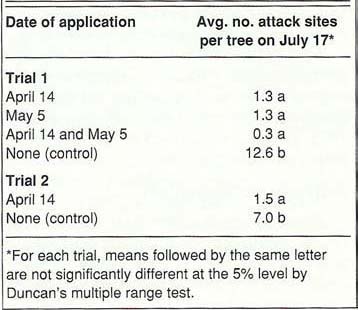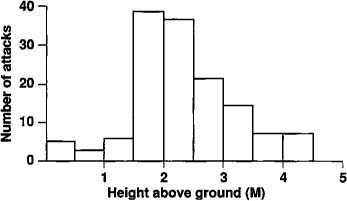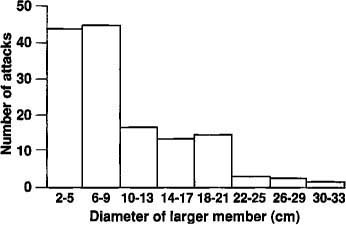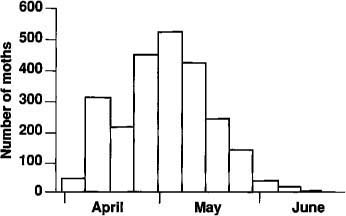All Issues
Controlling ash, olive tree pest: Study describes ash borer infestations, tests management method
Publication Information
California Agriculture 45(5):32-33.
Published September 01, 1991
PDF | Citation | Permissions
Abstract
The ash borer represents a serious threat to ash and olive trees. Larvae invade trunks, and branches throughout the canopy. A single spray of chlorpyrifos applied during the moth flight season protected landscape ash from serious injury.
Full text
Branch dieback associated with ash borer infestation of ‘Raywood’ ash is shown above. Closeups illustrate damage to limb from multiple larval attacks (left) and frass and ooze from ash borer attack on tree trunk (below).
The ash borer, Podosesia syringae, a serious pest of ash and lilac in the eastern and midwestern United States, was discovered in Sacramento, California in May 1979 by T. D. Eichlin, senior insect biosystematist, California Department of Food and Agriculture. He captured an adult in a pheromone trap baited with clearwing moth sex attractant.
In 1981, a larval specimen was taken from Moraine ash, Fraxinus holotricha ‘Moraine,’ and brought to the Cooperative Extension office by an area homeowner. A short time later, lilac and landscape-grown olive were also confirmed as hosts. The following year the ash borer was found in pheromone traps deployed in Stanislaus and San Joaquin counties. However, a decline of ash trees resulting from borer infestations has not been observed in those counties. In 1988, the ash borer was discovered in infested ash trees in Alameda County. Borer infestations have also been reported, though not confirmed, in ‘Raywood’ ash in Yolo and Sonoma counties.
The life cycle of Podosesia is well understood from investigations of workers from the eastern United States. Moths, which bear a striking resemblance to Polistes wasps, emerge in the spring and early summer, depending on locality. Females deposit their eggs on the woody parts of hosts. The larvae then tunnel through and mine beneath the bark and into heartwood until pupation late the following winter or early spring. Mining causes dieback of twigs and branches and often results in the death of the entire plant. There is one annual generation in California.
In most parts of North America, infestations of ash by the borer occur primarily in green ash, Fraxinus pennsylvanica. In California, however, Raywood ash, F. oxycarpa ‘Raywood’, and Moraine ash were most seriously affected. Although moths have been caught in large numbers in traps placed in mature Arizona and Modesto ash trees, Fraxinus velutina and F. velutina ‘Modesto’, respectively, no apparent damage to the trees by ash borer has been observed. Because of host and climatic differences, as well as the increasing importance of the ash borer in California, we investigated the flight activity, tree infestation characteristics, attraction to wounds and chemical management of the ash borer in Sacramento County in 1989 and 1990.
Methods
To determine the distribution of borer infestations within trees, four infested Raywood ash trees were inspected August 15. An additional three Raywood ash were inspected on August 30, 1989. Attack sites were identified by frass or ooze, or both, issuing from gallery openings. Measurements were taken of the height above ground level of each attack site and diameter of the attacked trunk or branch at the point of infestation. When attack sites occurred at crotches, the larger limb was measured. The seven trees ranged in height from 16 to 19 ft and had been in the landscape 7 years.
Pheromone traps with synthetic clearwing moth sex attractant, reportedly effective for 75 days, were hung throughout Sacramento County by Master Gardener volunteers. Most traps were hung March 30 and 31. Volunteers hung traps 5 to 8 ft above ground in ash or other trees near ash and inspected the traps at least weekly until no moths were captured for two consecutive weeks. Captured moths were periodically submitted to the senior author for confirmation of their identity during the trapping period. Valid data were collected from 60 traps.
To establish whether moths were attracted to wounds for oviposition, on April 20, 1990, a single patch of bark (0.5 x 0.5 inches) was removed from each of 20 Raywood ash using a chisel. On the same trees and approximately 6 inches away from each wound, a control area of undamaged bark of the same size was defined with a felt pen marker.
We began our insecticide trials on two groups of Raywood ash trees during the early (April 14) and peak (May 5) moth flight periods. Chlorpyrifos (Dursban 50W) was applied as a full-coverage spray at 1 lb active ingredient per 100 gallons of water. Trial 1 plots contained single 8-year-old trees arranged in a completely randomized design with seven replications of four treatments (table 1). Trial 2°s 3-year-old trees were arranged in a completely randomized block design with eight single tree replications per treatment.
TABLE 1. Evaluation of chlorpyrifos sprays applied during moth flight for control of the ash borer in 1990
Treatment effectiveness was determined on July 17, 1990 by counting current-generation borer attacks on all trees, as indicated by the presence of fresh frass or ooze up to a height of 9 ft.
Results and discussion
Sites of ash borer larval attacks occurred from ground level through nearly the entire canopy of infested trees (fig. 1). Most attacks occurred at heights between 5 and 8 ft. Numerous entry sites were found on scaffolds and crotches arising from previous heading cuts. However, more sites were found on smaller branches up to 3.5 inches in diameter (fig. 2). This may be due to the high number of small branches in comparison to the number of scaffold limbs. Of 143 attacks recorded on the seven trees, 73% occurred at crotches and 27% on “internodal” areas between limbs.
The first ash borer moth was caught on March 30 and the last on June 23, 1990. The most moths were trapped during late April to mid-May (fig. 3). We determined that the sex attractant had remained attractive to moths throughout the experiment since counts from traps hung for the duration were consistent with counts from traps that had been lost and replaced late in the moth flight period.
The margins of 11 of the 20 bark patches removed with a chisel were infested by ash borer larvae when examined on July 11, 1990. None of the 20 marking pen control areas were infested. This trial demonstrates why trees injured by improper staking, lawn mowers or string trimmers are preferentially infested. Podosesia was frequently found to re-attack trees at sites injured by previous generations of the insect.
Preventing injuries to ash trees will reduce the intensity of infestations by the ash borer. Also, large pruning wounds such as those caused by heading cuts should be avoided. As has been demonstrated for several other insects, injuries made prior to or during the insect flight period are more likely to be infested than injuries made during other times of the year.
Sprays of chlorpyrifos during the moth flight period resulted in significantly fewer borer attacks, when compared to untreated controls (table 1). In trial 1, a spray applied April 14, early in the flight period (fig. 3), was as effective as a spray applied May 5, at peak flight. Two applications were not significantly better than one early or one peak-flight spray. Workers in the midwestern and eastern United States found that a single application of chlorpyrifos 10 to 14 days after males were first captured in traps effectively protected ash trees from infestation. Our findings suggest that this application may be delayed up to 5 weeks after initial moth flight without compromising efficacy.
Fig. 1. Height above ground level of 143 attack sites of larval ash borers on 7 trees. Conversions: 1M = 3.28 ft; 2M = 6.56 ft, and so on.









